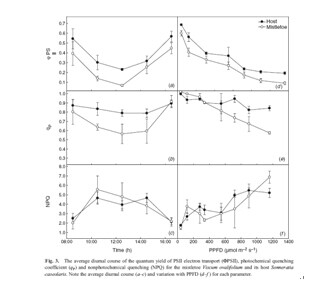Luzhen Chen, Li Huang, Xiaofei Li, Siyang You, Shengchang Yang
,Yihui Zhang Wenqing Wang.Functional Plant Biology, 2013, 40:
475–483.
Xylem-tapping mistletoes are
known to have generally higher transpiration rate (Tr), lower CO2 assimilation rate
(A) and therefore lower water-use efficiency (WUE) than their hosts. There are
long-standing contradictions in water relations and nitrogen use in
photosynthesis. Gas exchange, chlorophyll fluorescence and nutrition components
were investigated in a special mistletoe–host pair, Viscum
ovalifolium–Sonneratia caseolar is, as the host was a mangrove growing in a
saline environment. Our results show that both plants had high foliar N
content, therefore it was consistent with the Nparasitism hypothesis, although
the mistletoe had a lower Tr than its mangrove host. It was suggested that the
mistletoe reduces its Tr under salt stress with N sufficient conditions. The
mistletoe had a fundamental limitation of photosynthesis, and was
photoinhibited with regard to high salinity, but it developed more
photoprotection to thermal radiation. Additionally, both stomatal conductance
(gs) and mesophyll conductance (gm) limitations on photosynthesis dominated in
the mistletoe under salt stress even though it had a high foliar N content
similar to the host.

返回

